Sensory system issues such as diabetes mellitus, thiamine deficiency, and neurotoxin require a series of tests during their examination depending on the patient's symptoms. One of the tests is Pain and Light Touch Sensation that involves the patients touching the respective objects (needle and brush) before their fear is alleviated. A series of tests are done at intervals of five seconds until the patient feels a difference in sensation on either side of the body. From there, the corresponding nerve root for the patient areas can be noted effectively. The position sense involves client reporting when their large toe is placed up or down. Toes from both feet are involved in the test.
Stereognosia test is performed by asking the patient to name the object placed on their right palms eyes closed. Any deviances from the normal may suggest a problem with the dorsal column system or the spinothalamic tract depending on the area the test is performed. The same procedure is repeated for the other palm from where the doctor can deduce a lesion in the sensory cortex. Graphesthesia test involves the client identifying a letter written at their palm on either hand. Any abnormalities may suggest cortical damage. Finally, the extinction test involves letting the client sit at the table's end eyes closed and touching them at their trunk or legs. They are then asked to touch the areas felt of sensation. Later, one is required to touch two simultaneous regions, and as soon as they cannot identify them, extinction can be deemed present.
Article Summary
The article involves spine pathology, and in particular non-compressive Myelopathy, a diagnosis for spine conditions. The 80-year-old case involves a deficiency of B12 that led to subacute combined degeneration (SCD) implications on the dorsal column. The symptoms exhibited involved numbness and paresthesia in his arms and legs, atypical ocular Migraines, as well as transient visual field loss in his right eye (Alonso et al. 49). Physical tests revealed hyperreflexia in approximately his entire limbs. He also experienced proprioception from the Romberg's test. MRI tests revealed a complete blood count (CBC). This was preoperative work for the patient, which should have a father involved red blood cell measurements. However, for the old, the results cannot be relied upon, and further SCD concluded a diagnosis of megaloblastic anemia besides their previous B12 deficiency. The most interesting factor was the unilateral visual field defect that discredited optic neuropathy. B12 was the major contributing factor to cervical myelopathy. Preliminary care for his condition involved cyanocobalamin injections for four weeks.
Question 1
A case study is a research method that involves empirical inquiry and investigation of a subject of study and the related contextual conditions within the real-life context. They comprise of in-depth assessments of the factors leading to the underlying principles. Case studies are useful in research, especially when the participants have local knowledge that is beneficial for the study. It takes advantage of objectivity in reality, which means that the real-life can be assessed through scientific examination of empirical evidence.
Question 2
Evidence-based medicine is a medical approach that integrates research evidence with clinical expertise as well as patient values. It is considered an interdisciplinary approach that utilizes science, engineering, biostatistics, and epidemiology techniques, including decision-making, risk-benefit analysis, and meta-analysis. Its significance in clinical practice is to enable medical practitioners to judiciously, explicitly, and conscientiously utilize current best evidence in practice.
Work Cited
Alonso, Fernando, et al. "Subacute combined degeneration disguised as compressive myelopathy." The Spine Scholar, Volume 1, No. 1, 2017, 49-53.
Cite this page
Pain & Light Touch Tests: Examining Sensory System Issues. (2023, Feb 06). Retrieved from https://proessays.net/essays/pain-light-touch-tests-examining-sensory-system-issues
If you are the original author of this essay and no longer wish to have it published on the ProEssays website, please click below to request its removal:
- Essay on Public Health: Aim for Monitoring and Evaluation of Behavioural and Psychological Symptoms of Dementia
- Assignment Example on Public Health: Basic Biostatistics
- Nursing Professional and Academic Goals Essay
- Skin Cancer Prevention Based on Sun Awareness Paper Example
- Living Better: My Quest to Find Solutions to the World's Problems - Essay Sample
- Essay Example on Busy Patrol Unit's Performance Wanes: Investigating the Impact of Partner Dynamics
- DNP-Prepared Nurses: Unlocking Interprofessional Collaboration - Essay Sample







